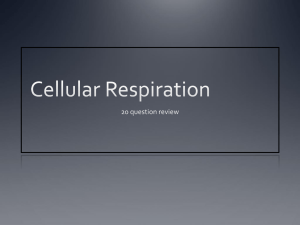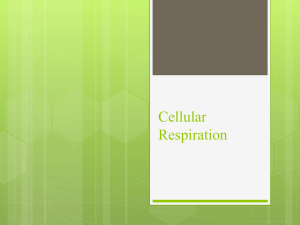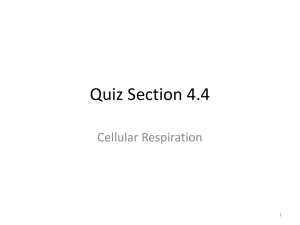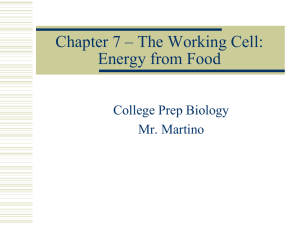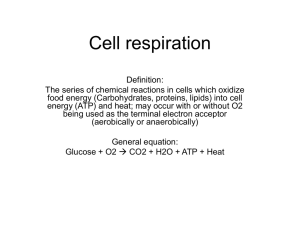2 ATP
advertisement
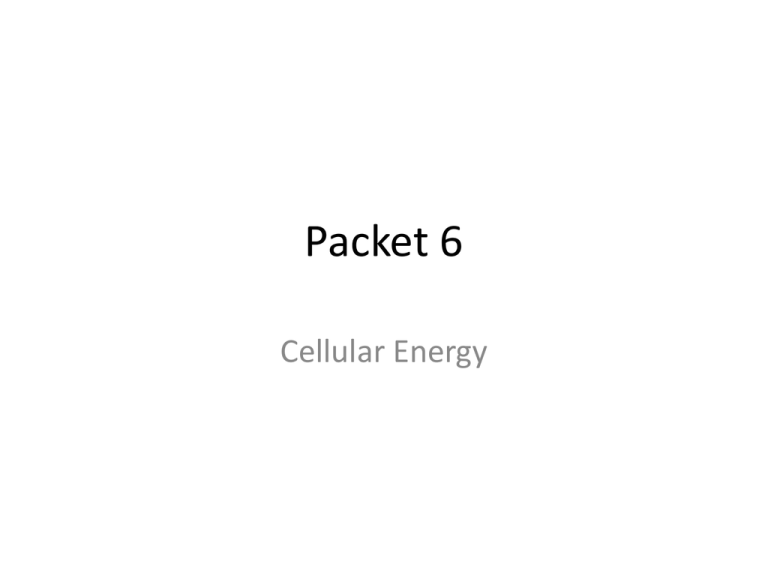
Packet 6 Cellular Energy ATP: cellular energy Why do cells need energy? • Cells carry out three kinds of energy-requiring work: – Chemical – Mechanical – Transport Making ATP: Aerobic cellular respiration Glycolysis (Stage 1) • Breaking down glucose – “glyco – lysis” (splitting sugar) glucose pyruvate 2x 3C 6C – Occurs in the cytoplasm – A little ATP energy is harvested, – but it’s inefficient • generate only 2 ATP for every 1 glucose Overview 10 reactions – convert glucose (6C) to 2 pyruvate (3C) – produces: 4 ATP & 2 NADH – consumes: 2 ATP – net yield: 2 ATP & 2 NADH Substrate-level phosphorylation Substrate-level phosphorylation Products of glycolysis move on to stage 2 or 3 Mitochondria — Structure • Double membrane – – – – – – smooth outer membrane highly folded inner membrane intermembrane space Matrix DNA, ribosomes enzymes outer intermembrane membrane inner space membrane cristae matrix mitochondrial DNA Stage 2: Pyruvate grooming and the Kreb’s Cycle This happens twice for each glucose molecule that started glycolysis…wh y? Cellular respiration Electron Transport Chain and Chemiosmosis: ATP payoff! • Electron Transport Chain – series of proteins built into inner mitochondrial membrane Remember the Electron Carriers? Glycolysis 2 NADH Time to break open the piggybank! Krebs cycle 8 NADH 2 FADH2 Electron Transport Chain What powers the proton (H+) pumps?… Electronegativity! Chemiosmosis and oxidative phosphorylation oxidative phosphorylation Cellular respiration 2 ATP + 2 ATP + 34 ATP Summary of cellular respiration C6H12O6 + 6O2 • • • • • • • • 6CO2 + 6H2O +~34-38 ATP Where did the glucose come from? Where did the O2 come from? Where did the CO2 come from? Where did the CO2 go? Where did the H2O come from? Where did the ATP come from? What is recycled for use again? Why do we breathe? Taking it beyond… • What is the final electron acceptor in Electron Transport Chain? O2 So what happens if O2 unavailable? ETC backs up nothing to pull electrons down chain NADH & FADH2 can’t unload H ATP production ceases cells run out of energy Anaerobic respiration Making ATP without oxygen • • All cells carry out glycolysis: prokaryotes and eukaryotes. Eukaryotes and many prokaryotes also carry out oxidative phosphorylation (remember this requires oxygen). How can some bacteria carry out aerobic respiration if they don't have mitochondria? FUN FACT: many bacteria have ETC’s in their cell membranes. Reminders! A net of 2 ATP is generated in glycolysis. NAD+ must be present available for this process. New considerations For aerobic organisms this is not a problem, NAD+ is regenerated by the ETC. Not all organisms can use oxygen, they are anaerobic Anaerobic organisms use glycolysis only to make ATP They regenerate , NAD+ through fermentation processes Alcohol fermentation Lactic acid fermentation Review: Answer all of the following questions in your notebook. • What are the products of pyruvate grooming for 1 molecule of glucose? • What are the products of the citric acid cycle for 1 molecule of glucose? • After glycolysis, pyruvate grooming, and the citric acid cycle, what are your net products? • What is phosphorylation? • What is substrate-level phosphorylation? • What is the main goal for stages 1-3? Review: Answer all of the following questions in your notebook • What is the summary equation for cellular respiration? • If oxidation is a loss of electrons (in the form of hydrogen atoms) and reduction is the gain of electrons (in the form of hydrogen atoms), – what is oxidized during cellular respiration? – what is reduced during cellular respiration? • How does glucose get to your cells for cellular respiration? • What is the point of cellular respiration? • What are the net molecular products of glycolysis? Where does glucose come from for cellular respiration? Photosynthesis! Photosynthesis Leaf structure Mesophyll cells Stomate Guard cells Vascular tissue Chloroplast structure Grana Thylakoid Stroma Double membran e Stage 1: Lightdependent reactions Light energy is converted to chemical energy (as NADPH and ATP). Stage 2: Calvin cycle Glucose is made from CO2 and hydrogens carried by NADPH using ATP energy. Calvin cycle SUMMARY What factors might affect the rate of photosynthetic reactions?



